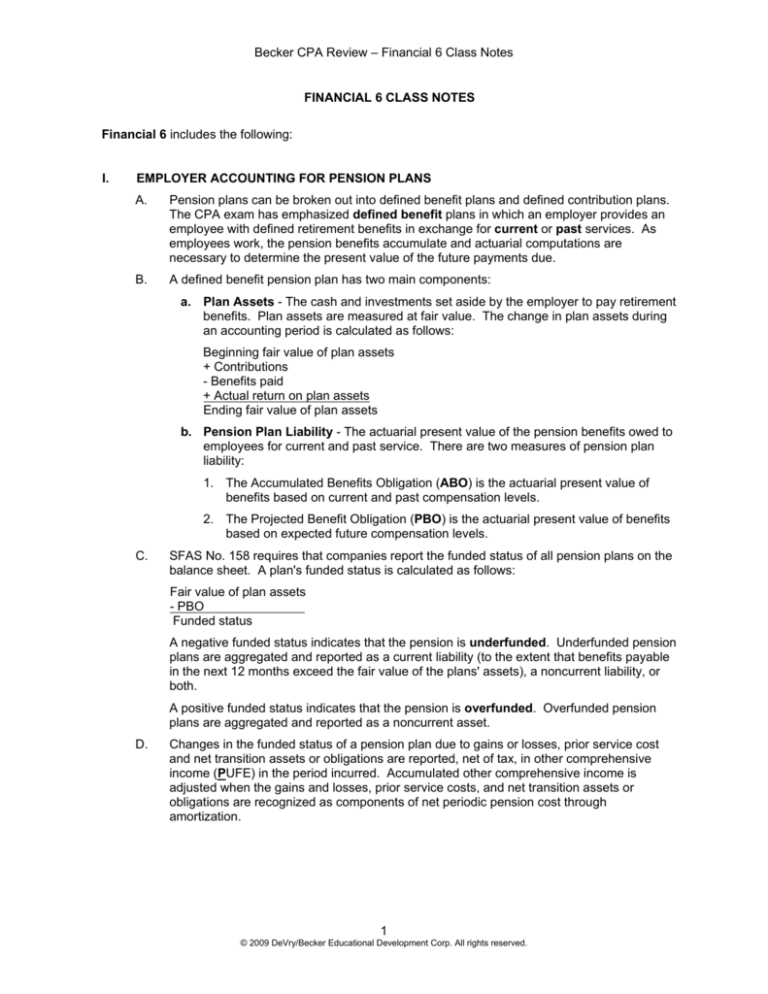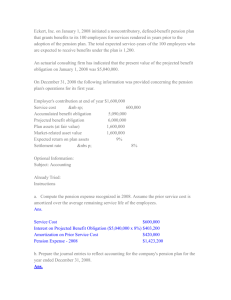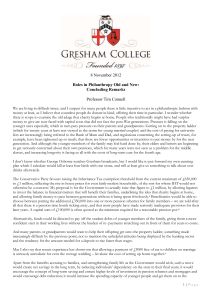
Becker CPA Review – Financial 6 Class Notes
FINANCIAL 6 CLASS NOTES
Financial 6 includes the following:
I.
EMPLOYER ACCOUNTING FOR PENSION PLANS
A.
Pension plans can be broken out into defined benefit plans and defined contribution plans.
The CPA exam has emphasized defined benefit plans in which an employer provides an
employee with defined retirement benefits in exchange for current or past services. As
employees work, the pension benefits accumulate and actuarial computations are
necessary to determine the present value of the future payments due.
B.
A defined benefit pension plan has two main components:
a. Plan Assets - The cash and investments set aside by the employer to pay retirement
benefits. Plan assets are measured at fair value. The change in plan assets during
an accounting period is calculated as follows:
Beginning fair value of plan assets
+ Contributions
- Benefits paid
+ Actual return on plan assets
Ending fair value of plan assets
b. Pension Plan Liability - The actuarial present value of the pension benefits owed to
employees for current and past service. There are two measures of pension plan
liability:
1. The Accumulated Benefits Obligation (ABO) is the actuarial present value of
benefits based on current and past compensation levels.
2. The Projected Benefit Obligation (PBO) is the actuarial present value of benefits
based on expected future compensation levels.
C.
SFAS No. 158 requires that companies report the funded status of all pension plans on the
balance sheet. A plan's funded status is calculated as follows:
Fair value of plan assets
- PBO
Funded status
A negative funded status indicates that the pension is underfunded. Underfunded pension
plans are aggregated and reported as a current liability (to the extent that benefits payable
in the next 12 months exceed the fair value of the plans' assets), a noncurrent liability, or
both.
A positive funded status indicates that the pension is overfunded. Overfunded pension
plans are aggregated and reported as a noncurrent asset.
D.
Changes in the funded status of a pension plan due to gains or losses, prior service cost
and net transition assets or obligations are reported, net of tax, in other comprehensive
income (PUFE) in the period incurred. Accumulated other comprehensive income is
adjusted when the gains and losses, prior service costs, and net transition assets or
obligations are recognized as components of net periodic pension cost through
amortization.
1
© 2009 DeVry/Becker Educational Development Corp. All rights reserved.
Becker CPA Review – Financial 6 Class Notes
E.
Net periodic pension cost (SIRAGE) is the net of six components:
1.
+ Current service cost [normal service cost]
2.
+ Interest cost
3.
- Expected return on plan assets
4.
+/- Amortization of prior service costs (cost of retroactive benefits due to changes in
plan)
5.
+/- Amortization of excess cumulative deferred gains/losses
6.
+/- Amortization of existing net obligation or net asset at implementation of plan
According to SFAS No. 158, the tax effects of the components of net period pension cost
must be recognized when net period pension cost is recorded.
II.
III.
IV.
ACCOUNTING FOR POSTRETIREMENT BENEFITS OTHER THAN PENSIONS
A.
The cost of retirement health care and other benefits is accrued if the obligation is
attributable to services already rendered, these rights accumulate or "vest," payment is
probable and the amount can be reasonably estimated.
B.
Benefits are accrued over the attribution period, the period from the date of hire to the
date fully eligible for the benefit.
C.
Postretirement benefit plans must be reported as outlined in SFAS No. 158, as described
above for pension plans.
ACCOUNTING FOR POSTEMPLOYMENT BENEFITS
A.
These benefits (severance pay, salary continuation, etc.) are enjoyed after employment
and are not the same as post retirement benefits.
B.
GAAP requires the accrual of a liability if the same four criteria as for postretirement
benefits are met.
CONTINGENCIES
A.
Contingencies are existing conditions whose outcome depends on some future event or
occurrence. The three categories of contingencies are probable, reasonably possible
and remote.
B.
Loss contingencies that are probable and can be reasonably estimated must be accrued.
If a range of losses is given, the minimum amount is accrued and the remaining amount is
disclosed in a footnote. Gain contingencies that are probable are not accrued but are
disclosed.
C.
The nature and amount of a loss or gain contingency that is reasonably possible is
disclosed in the footnotes and is not accrued.
D.
Remote contingencies are generally ignored.
E.
Unasserted claims follow similar rules for disclosure and/or accrual.
2
© 2009 DeVry/Becker Educational Development Corp. All rights reserved.
Becker CPA Review – Financial 6 Class Notes
V.
INTERPERIOD ACCOUNTING FOR INCOME TAXES
A.
GAAP and tax accounting rules differ considerably. Some of the differences are
permanent because they never reverse. Other differences are temporary because they
involve mere timing differences between the financial and tax accounting rules.
B.
Only temporary differences cause deferred tax consequences.
C.
Tax expense is subdivided into two components: current tax expense [CTE] and deferred
tax expense [DTE].
D.
Current tax expense [CTE] is merely the result of multiplying taxable income from the
tax return by the tax rate. The exam routinely ignores estimated tax payments by firms.
E.
The deferred tax account(s) in the balance sheet must be adjusted at the end of each year
to reflect the appropriate amount of deferred tax liability [DTL] or the appropriate amount of
a deferred tax asset [DTA].
F.
Permanent differences, such as tax-exempt interest on municipal bonds, or life insurance
premiums when the corporation is beneficiary, are embedded in tax law and will not
reverse in the future; therefore they only affect current tax paid and not the deferred tax
accounts.
G.
Temporary differences will "turn around" in the future and are part of the deferred tax
calculations. GAAP requires accrual accounting, while tax law treats some items on a
"cash basis": e.g., estimated liabilities or bad debt expense. Since these are recognized for
book purposes before they are deductible for tax purposes, a deferred tax asset (DTA) will
result. Using straight-line depreciation for the books and MACRS for tax purposes will
result in lower taxable income in the early years of the asset life and a deferred tax liability
(DTL). The Corporate Taxation Summary on page F6-48 gives an excellent breakdown
of various differences between book and tax income.
H.
DTAs and DTLs must be re-calculated each year based on enacted tax rates in the year(s)
in which the taxable item is expected to be realized or paid.
I.
For Balance Sheet presentation, deferred tax items are classified as they relate to current
or noncurrent assets and liabilities. DTAs and DTLs classified as current are netted
together and only one account appears on the Balance Sheet. Noncurrent DTAs and
DTL's receive similar treatment.
J.
If it is more likely than not that all or part of a deferred tax asset will not be realized, a
valuation allowance must be set up to reduce the asset.
K.
Operating loss carrybacks are "assured" and can be recognized as a reduction in the
book loss in the year of the loss. An operating loss carryforward is a DTA and is
recognized to the extent that it is "more likely than not to be realized." Undistributed
earnings of an investee are presumed to be distributed in the future and are a temporary
difference.
Intraperiod tax allocation relates to apportioning the total tax provision among the various Income
Statement sections (IDEA) from F1.
The Required Reading reviews Other Liabilities that have some history on the CPA exam. There are
also two appendices adding more detail on defined benefit pension plans.
3
© 2009 DeVry/Becker Educational Development Corp. All rights reserved.






